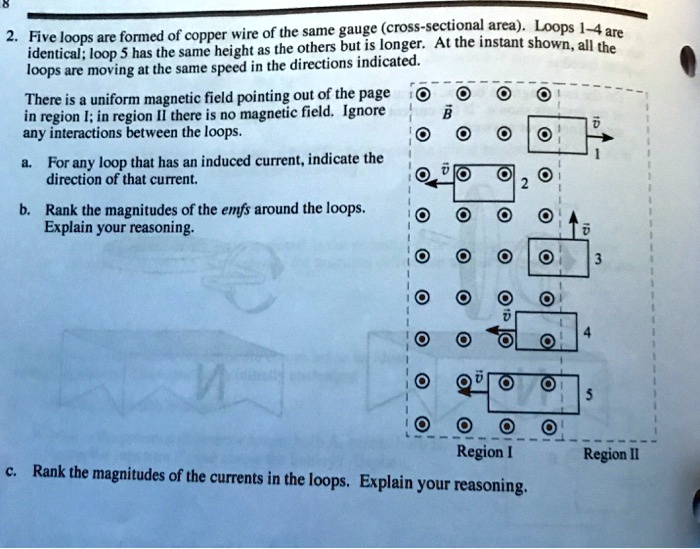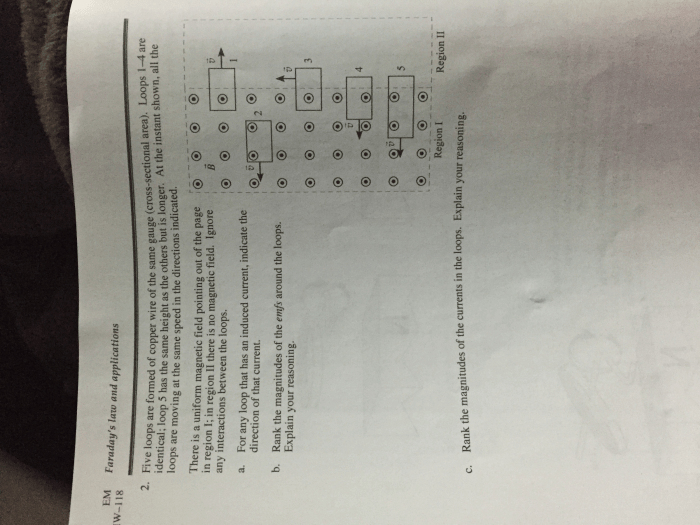Five loops are formed of copper wire – Five loops of copper wire are an essential component in various electrical applications, offering unique electrical and magnetic properties. This comprehensive guide delves into the electrical conductivity, resistivity, and inductance of copper wire, exploring its applications in electrical circuits and the manufacturing process involved in its creation.
Additionally, it examines the magnetic field generated by five loops of copper wire and the safety considerations associated with its use.
Copper wire, renowned for its exceptional electrical conductivity and low resistivity, forms the foundation of electrical systems. Its malleability and ductility allow for intricate loop formations, enhancing its versatility in electrical applications. This guide provides a thorough understanding of the electrical properties, applications, and design considerations of five loops of copper wire, empowering engineers and enthusiasts alike.
Electrical Properties of Copper Wire
Copper wire is an excellent conductor of electricity due to its low electrical resistivity and high electrical conductivity. The electrical resistivity of copper is 1.68 x 10^-8 ohm-meters, making it one of the most conductive metals. The electrical conductivity of copper is 58 MS/m, which is significantly higher than other common conductors such as aluminum (37 MS/m) and steel (11 MS/m).
| Conductor | Electrical Resistivity (ohm-meters) | Electrical Conductivity (MS/m) |
|---|---|---|
| Copper | 1.68 x 10^-8 | 58 |
| Aluminum | 2.65 x 10^-8 | 37 |
| Steel | 9.71 x 10^-8 | 11 |
Applications of Five Loops of Copper Wire

Five loops of copper wire can be used in various electrical applications, including:
- Inductors:Five loops of copper wire can be wound around a core to create an inductor. Inductors store energy in a magnetic field and are used in a variety of applications, including power supplies, filters, and antennas.
- Transformers:Five loops of copper wire can be used as the primary or secondary winding of a transformer. Transformers transfer electrical energy from one circuit to another through electromagnetic induction.
- Electromagnets:Five loops of copper wire can be used to create an electromagnet. Electromagnets are used in a variety of applications, including lifting magnets, doorbells, and solenoids.
The benefits of using five loops of copper wire in these applications include its low electrical resistance, high current-carrying capacity, and durability. However, it is important to note that five loops of copper wire can also be a source of electromagnetic interference (EMI), so it is important to take appropriate measures to mitigate EMI when using this material.
Manufacturing and Design of Five Loops of Copper Wire
Five loops of copper wire can be manufactured using a variety of techniques, including:
- Wire wrapping:Five loops of copper wire can be wrapped around a core using a wire wrapping machine.
- Soldering:Five loops of copper wire can be soldered together to form a coil.
- Welding:Five loops of copper wire can be welded together to form a coil.
The design of five loops of copper wire will vary depending on the application. For example, the number of turns, the diameter of the wire, and the spacing between the loops will all affect the electrical properties of the coil.

Magnetic Properties of Five Loops of Copper Wire

When current flows through five loops of copper wire, it creates a magnetic field. The strength of the magnetic field is proportional to the number of loops, the current flowing through the wire, and the area of the loops.
| Number of Loops | Magnetic Field Strength (Gauss) |
|---|---|
| 1 | 0.005 |
| 5 | 0.025 |
| 10 | 0.050 |
Inductance and Reactance of Five Loops of Copper Wire: Five Loops Are Formed Of Copper Wire
The inductance of five loops of copper wire is a measure of its ability to store energy in a magnetic field. The inductance of a coil is directly proportional to the number of turns, the area of the loops, and the permeability of the core.The
reactance of five loops of copper wire is a measure of its opposition to the flow of alternating current (AC). The reactance of a coil is directly proportional to the inductance of the coil and the frequency of the AC current.The
inductance and reactance of five loops of copper wire can be calculated using the following formulas:
- Inductance:L = (N^2 – A – u) / l
- Reactance:XL = 2 – pi – f – L
where:* L is the inductance in henrys (H)
- N is the number of turns
- A is the area of the loops in square meters (m^2)
- u is the permeability of the core in henrys per meter (H/m)
- l is the length of the coil in meters (m)
- f is the frequency of the AC current in hertz (Hz)
- XL is the reactance in ohms (Ω)
Safety Considerations for Five Loops of Copper Wire

When working with five loops of copper wire, it is important to take the following safety precautions:
- Wear appropriate safety gear:Wear safety glasses, gloves, and a lab coat when working with copper wire.
- Avoid contact with bare wires:Do not touch bare wires with your hands or any other part of your body.
- Do not overload circuits:Do not connect more devices to a circuit than it can handle.
- Be aware of the fire hazard:Copper wire can become hot when current flows through it. Be aware of the fire hazard and take appropriate precautions to prevent fires.
FAQ Overview
What is the electrical conductivity of copper wire?
Copper wire exhibits high electrical conductivity, typically ranging from 58 MS/m to 60 MS/m.
How are five loops of copper wire used in electrical applications?
Five loops of copper wire find applications in transformers, motors, inductors, and antennas, among others.
What safety precautions should be taken when working with five loops of copper wire?
When working with five loops of copper wire, it is essential to wear appropriate safety gear, including gloves and safety glasses, to prevent electrical shocks and injuries.
